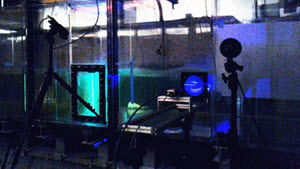
A close up of major equipment used in the experimental set up in the University of Miami ASSIST facility. The equipment includes (left to right) the wave slope gauge, the Particle Image Velocimetry (PIV)/bubble imager, and spray shadowgraph. (Photo by Will Drennan)
Interactions among wind, waves, and upper-ocean currents are essential factors in predicting oil slick transport and fate. These complex interactions, however, make capturing their dynamics in simulations challenging, especially when turbulent weather conditions are present.
The Gulf of Mexico Research Initiative recently awarded Dr. William Drennan a grant to study how wind-wave-current interactions affect oil transport under significant wave influences, such as hurricanes. The researchers are taking a two-step approach that combines model simulations with parameters derived from laboratory wave tank experiments. Their goal is to improve our ability to monitor and contain oil in the event another spill occurs under high-turbulence conditions.
“The more oil that gets away from us, the more oil that ends up in the ecosystem somewhere,” said Drennan. “Our goal is that, if there is another spill like this, we will be able to better prepare and make the clean up more efficient. If there’s a big storm coming, we need to modify how we react to the spill and capture the oil that will escape from the spill area as a result.”

The ASIST flume experiment while underway, using the laser light for the slope gauge and the backlight of the PIV. (Photo by Will Drennan)
Co-Principal Investigator Dr. Lian Shen is simulating wind, waves, and ocean currents using a suite of state-of-the-art wave-resolving models to visualize the spray, bubbles, and oil transport pathways that result from breaking waves under various sea conditions. The models will help capture the processes essential to ocean wave-field dynamics so that researchers can observe where oil goes in simulations.
The model’s simulations need to be realistic so that results represent oil’s behavior in the ocean.
Drennan is simulating breaking waves using unique and advanced wind-wave tank facilities in the University of Miami’s Surge-Structure-Atmosphere Interaction (SUSTAIN) laboratory. Observations from experiments in the tanks will help him map the wave topography in great detail and inform and calibrate Shen’s models. Drennan is measuring spray and bubble behavior under various wind and wave conditions (including a Category 5 hurricane) with and without oil present. He is incorporating these laboratory measurements into the models to provide a detailed 3D description – a necessary dataset to construct the wind, waves, and currents field and develop a deeper understanding of their physical processes.
Drennan reflected on the project’s motivations for focusing on transport under significant wave influences, “As long as we’re going to be producing oil in areas where there are hurricanes or tropical storms, we need to understand how to respond to a potential disaster under those conditions. It’s interdisciplinary, because the consequences of a disaster affect everything from marine life to fisheries to coastal resilience. If we can prepare and respond better to a disaster, then we can avoid some of the really negative consequences.”
The project’s researchers are William Drennan at the University of Miami Rosenstiel School of Marine and Atmospheric Science and Lian Shen at the University of Minnesota Department of Mechanical Engineering. Their project is Investigation of Oil Spill Transport in a Coupled Wind-Wave Current Environment Using Simulation and Laboratory Studies.
************
The Gulf of Mexico Research Initiative (GoMRI) is a 10-year independent research program established to study the effect, and the potential associated impact, of hydrocarbon releases on the environment and public health, as well as to develop improved spill mitigation, oil detection, characterization and remediation technologies. An independent and academic 20-member Research Board makes the funding and research direction decisions to ensure the intellectual quality, effectiveness and academic independence of the GoMRI research. All research data, findings and publications will be made publicly available. The program was established through a $500 million financial commitment from BP. For more information, visit http://gulfresearchinitiative.org/.
© Copyright 2010- 2017 Gulf of Mexico Research Initiative (GoMRI) – All Rights Reserved. Redistribution is encouraged with acknowledgement to the Gulf of Mexico Research Initiative (GoMRI). Please credit images and/or videos as done in each article. Questions? Contact web-content editor Nilde “Maggie” Dannreuther, Northern Gulf Institute, Mississippi State University (maggied@ngi.msstate.edu).
